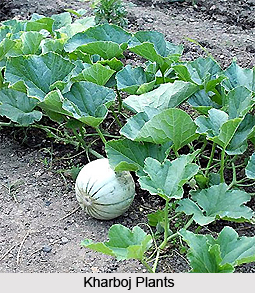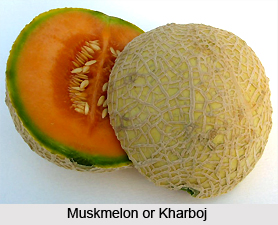 The plant named Kharboj has the botanical name of Cucumis melo L and it is known as Muskmelon or Sweet melon in English. Ervaru is the Sanskrit name of the plant and Kharboj is its Hindi name. The other Sanskrit names of the plant are Ervaruh and Karkati and it is also called as Kharbuja in Hindi. The plant has several other names in different native Indian languages. The Bengali speaking people call it as Kakri and Kharmuj, its name in Gujarati is Chibdu and it is called as Chibunda or Kharbuja in Marathi. The Tamil names of the plant are Karbujadosa, Kattuttumatti, Mulampazham, Peddadosrai and Peddakai and in Telugu, it is known as Kharbujadosa.
The plant named Kharboj has the botanical name of Cucumis melo L and it is known as Muskmelon or Sweet melon in English. Ervaru is the Sanskrit name of the plant and Kharboj is its Hindi name. The other Sanskrit names of the plant are Ervaruh and Karkati and it is also called as Kharbuja in Hindi. The plant has several other names in different native Indian languages. The Bengali speaking people call it as Kakri and Kharmuj, its name in Gujarati is Chibdu and it is called as Chibunda or Kharbuja in Marathi. The Tamil names of the plant are Karbujadosa, Kattuttumatti, Mulampazham, Peddadosrai and Peddakai and in Telugu, it is known as Kharbujadosa.
Kharboj is a small, slender, perennial and climbing or creeping herb, having a thick rootstock. The leaves of the plant are sub-orbicular, 5-angled or lobed, and they are scabrous on both surfaces. The leaves are cordate at base, having a length of 9 cm and width of 8 cm. The petioles of the plant are 5 cm long.
 The plant`s flowers are small, yellow-coloured, solitary and the male flowers are borne in small clusters, while the females are borne solitary. The fruit or berry of the plant is rounded or ellipsoid, obscurely trigonous, smooth and it has a length of 5 cm long and diameter of 4 cm. The fruit becomes yellow-coloured with age, and it has green stripes when young. The seeds are obovoid and rounded at apex. The plant usually flowers between the months of July and August, and fruits in August and September, in central India.
The plant`s flowers are small, yellow-coloured, solitary and the male flowers are borne in small clusters, while the females are borne solitary. The fruit or berry of the plant is rounded or ellipsoid, obscurely trigonous, smooth and it has a length of 5 cm long and diameter of 4 cm. The fruit becomes yellow-coloured with age, and it has green stripes when young. The seeds are obovoid and rounded at apex. The plant usually flowers between the months of July and August, and fruits in August and September, in central India.
Kharboj plant is being extensively cultivated in India, mainly because of its fruits that are eaten as a vegetable in many tropical countries. The plant is sometimes naturalized in open scrub forests, in India, as well. The plant has some medicinal properties and usages also. The seeds of the plant are considered as diuretic and cooling and the pulp of its fruit is diuretic and demulcent. The Indian people use the pulp for removing tan freckles and for treating chronic eczema. Apart from that, the fruit of Ervaru or Kharboj plant is reported to be used for treating ophthalmia and urinary discharges, in Unani medicine, as well.



















